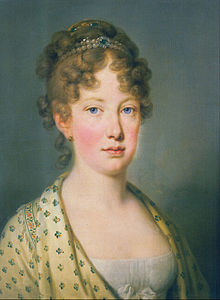Maria Leopoldina, Archduchess of Austria
| Maria Leopoldina of Austria | |||||
|---|---|---|---|---|---|

Leopoldina at age 18, 1815
|
|||||
| Empress consort of Brazil | |||||
| Reign | 12 October 1822 – 11 December 1826 | ||||
| Queen consort of Portugal and the Algarves | |||||
| Reign | 10 March 1826 – 2 May 1826 | ||||
| Born | 22 January 1797 Schönbrunn Palace, Vienna, Austria, Holy Roman Empire |
||||
| Died | 11 December 1826 (aged 29) São Cristóvão Palace, Rio de Janeiro, Empire of Brazil |
||||
| Burial | 1954 Monument to the Independence of Brazil, São Paulo, Brazil |
||||
| Spouse | Pedro I of Brazil and IV of Portugal | ||||
| Issue among others... |
|||||
|
|||||
| House | Habsburg-Lorraine | ||||
| Father | Francis II, Holy Roman Emperor | ||||
| Mother | Maria Teresa of Naples and Sicily | ||||
| Religion | Roman Catholicism | ||||
| Full name | |
|---|---|
| German: Caroline Josepha Leopoldine Franziska Ferdinanda |
|
Styles of Empress Leopoldina of Brazil |
|
|---|---|
 |
|
| Reference style | Her Imperial Majesty |
| Spoken style | Your Imperial Majesty |
| Alternative style | Madam |
Dona Maria Leopoldina of Austria (22 January 1797 – 11 December 1826) was an archduchess of Austria, Empress consort of Brazil and Queen consort of Portugal.
She was born in Vienna, Austria, as the daughter of Holy Roman Emperor Francis II, and his second wife, Maria Teresa of Naples and Sicily. Among her many siblings were Emperor Ferdinand I of Austria and Marie Louise, Duchess of Parma, the wife of Napoleon Bonaparte. She was also the great-niece, through her paternal Grandfather, of the ill-fated Queen Marie Antoinette of France.
Leopoldina was born on 22 January 1797 in Schönbrunn Palace, in Vienna, Archduchy of Austria. She was given the name Caroline Josepha Leopoldine Franziska Ferdinanda, according to her biographer Carlos H. Oberacker, and confirmed by Bettina Kann in her work "Cartas de uma Imperatriz", who mentioned a contemporary source: the Austrian newspaper Wiener Zeitung of 25 January 1797, who gave the news of the birth of the Archduchess three days before with her full name. According to Oberacker, the name "Maria" wasn't present in the preserved baptismal record of the Archduchess, and she began to use it only during her journey to Brazil, where she began to be named Maria Leopoldina in all documents, including the Constitutional oath of 1822. According to another theory presented by Oberacker, the Archduchess probably began to use the name "Maria" due to her great devotion to the Virgin Mary and because all her sisters-in-law used this name.
...
Wikipedia
